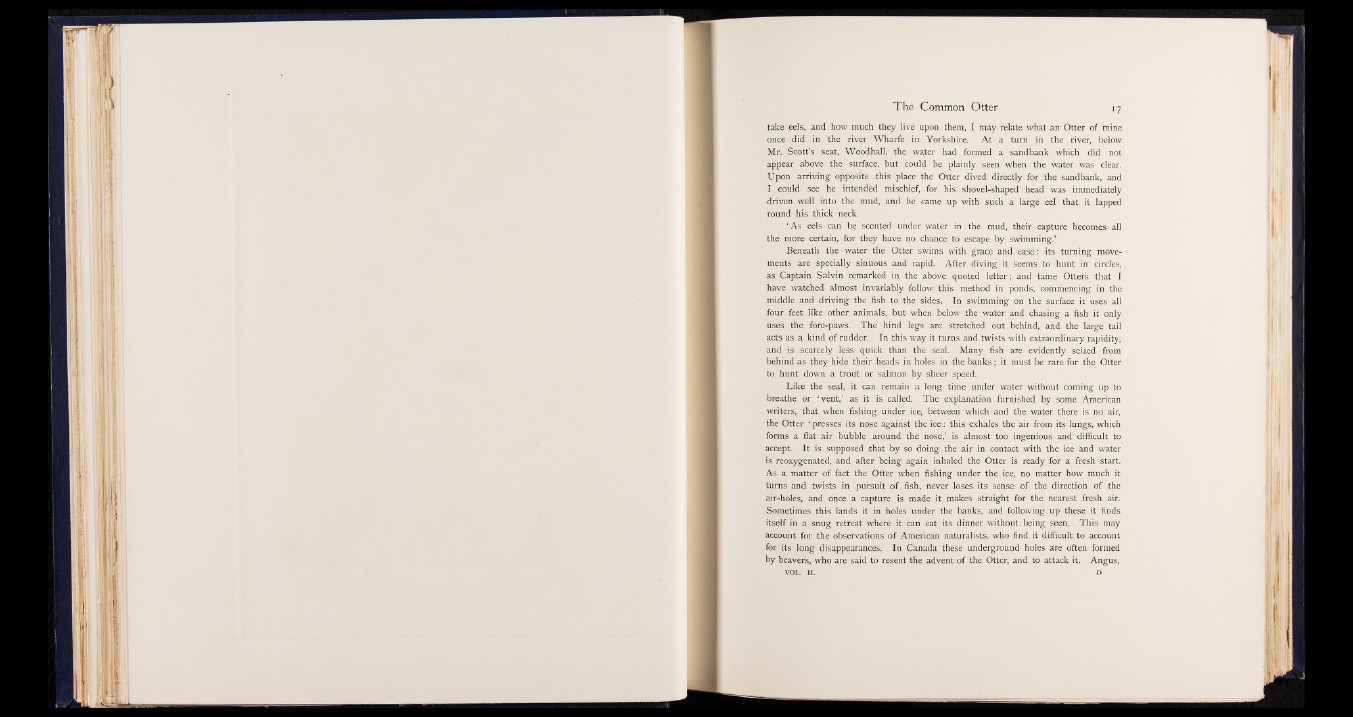
The Common Otter 17
take eels, and how much they live upon them, I may relate what an Otter of mine
once did in the river Wharfe in Yorkshire. At a turn in the river, below
Mr. Scott’s seat, Woodhall, the water had formed a sandbank which did not
appear above the surface, but could be plainly seen when the water was clear.
Upon arriving opposite this place the Otter dived directly for the sandbank, and
I could see he intended mischief, for his shovel-shaped head was immediately
driven well into the mud, and he came up with such a large eel that it lapped
round his thick neck.
‘ As eels can be scented under water in the mud, their capture becomes all
the more certain, for they have no chance to escape by swimming.’
Beneath the water the Otter swims with grace and ease: its turning movements
are specially sinuous and rapid. After diving it seems to hunt in circles,
as Captain Salvin remarked in the above quoted letter; and tame Otters that I
have watched almost invariably follow this method in ponds, commencing in the
middle and driving the fish to the sides. In swimming on the surface it uses all
four feet like other animals, but when below the water and chasing a fish it only
uses the fore-paws. The hind legs are stretched out behind, and the large tail
acts as a kind of rudder. In this way it turns and twists with extraordinary rapidity,
and is .scarcely less quick than the seal. Many fish are evidently seized from
behind as they hide their heads in holes in the banks; it must be rare for the Otter
to hunt down a trout or salmon by sheer Speed.
Like the seal, it can remain a long time under water without coming up to
breathe or ‘ vent,’ as it vis called. The explanation furnished by some American
writers, that when fishing under ice, between which and the water there is no air,
the Otter ‘ presses its nose against the ice: this exhales the air from its lungs, which
forms a flat air bubble around the nose,’ is almost too ingenious and difficult to
accept. It is supposed that by so doing the air in contact with the ice and water
is reoxygenated, and after being again inhaled the Otter is ready for a fresh start.
As a matter of fact the Otter when fishing under the ice, no matter how much it
turns and twists in pursuit of fish, never loses its sense of the direction of the
air-holes, and once a capture is made it makes straight for the nearest fresh air.
Sometimes this lands it in holes under the banks, and following up these it finds
itself in a snug retreat where it can eat its dinner without being seen. This may
account for the observations of American naturalists, who find it difficult to account
for its long disappearances. In Canada these underground holes are often formed
by beavers, who are said to resent the advent of the Otter, and to attack it. Angus,
VOL. II.